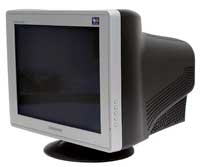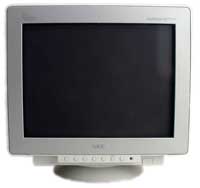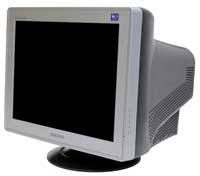Buyer's Guide - Entry Level, January 2005
by Jarred Walton on January 9, 2005 12:05 AM EST- Posted in
- Guides
Displays
For our displays, we continue to stick with CRTs due to pricing concerns - LCDs simply do not qualify as a budget part. The number of actual tube manufacturers is very small these days, as most display companies have moved on to the more profitable LCD sector, so differences between models are not all that great. What we really want out of a display is a decent refresh rate, a crisp picture, and above all, a flat surface. Convex monitors have been undesirable for over a decade, and we're more than willing to spend a bit more money in order to get a truly flat screen. This means that we're going with aperture grille displays, which some people do not like because of the two thin lines that are visible. We hardly notice the lines and will favor the flatter screens and brighter colors, but some people prefer invar shadow mask CRTs.  |
 |
| Click images to enlarge. | |
Display Recommendation: Samsung 793DF/793MB or NEC FE771SB 17" CRT
Price: $145 or $160 shipped
The best all-around option for a quality CRT is really a tie right now between the Samsung and the NEC offerings. NEC models tend to cost a bit more, but we're talking about a price difference of less than 10%. You can also find these displays at several of the larger computer stores, i.e. Best Buy and CompUSA, and when combined with special price discounts, you may be able to get them for substantially less money than we've listed here. As far as features go, both the Samsung and NEC displays are nearly identical. The NEC offers a feature called "Super Bright", which will bump up the brightness levels dramatically. It's almost painful to look at text with the SB mode turned on, but when watching movies or playing games, it actually works quite well. Samsung offers a similar feature with their "Magic Bright" technology - this is only available on the "MB" model and not on the "DF" model, however. As for the overall look, Samsung goes with a two-tone and NEC sticks with a solid color. Samsung also places the controls on the side of the monitor while NEC places them on the bottom. The two-tone color effect is one that you will probably either love or hate; personally, we think it looks pretty good and matches up with black or beige cases relatively well. As for the controls, we find the NEC positioning and menus to be more useful, but maybe we're just more used to that setup. Either one will get the job done quite well. Of course, it may be easier to find one or the other depending on where you shop.
The one feature that we miss is the lack of a 75 Hz or higher refresh rate at the maximum resolution. Unfortunately, this appears to be the case with nearly all 17" CRTs; finding a 17" monitor with a higher refresh rate is relatively difficult, and the only readily available option is Viewsonic. Unfortunately, we've heard quite a few bad experiences with Viewsonic monitors - many report that they burn out after a few years - and so we hesitate to recommend them. We feel that most displays should easily last 5 years, if not more, so when we see a lot of comments about replacing two Viewsonic CRTs in a five year span, it makes us nervous. Besides, you can get larger displays with higher supported resolutions and refresh rates for only a bit more than a "high-end" 17" CRT. Rather than spending $180 for a 17" display with an 85 Hz refresh rate at 1280x1024, we would just as soon spend the extra $20 to move up to a 19" CRT. That brings us to our alternative display recommendation.
Display Alternative: Samsung 997DF 19" CRT
Price: $215 shipped
Moving up to the realm of 19" displays, we feel that Samsung easily wins this category. They continue to offer a perfectly flat screen, and they increase the maximum resolution to 1920x1440. That may not be the most useful resolution for practical use, unless your eyesight is far better than average, but the1600x1200 resolution at a 75 Hz refresh rate is quite good. Unlike the 17" category, there are some differences between Samsung and the chief rival NEC FE991SB. NEC continues to offer their Super Bright mode while Samsung does not offer Magic Bright. It's a relatively minor omission, however, and not worth the additional $60 that the NEC would cost. NEC also offers a lower maximum resolution of 1792x1344, but considering both brands have a 96 KHz horizontal frequency, the useful resolutions are still basically a tie. If you can afford the additional $75 or so, a good quality 19" display can last a long time.
One thing that can be somewhat irritating is trying to find maximum supported refresh rates for monitors. Some companies are better than others at reporting such values, but others like to avoid listing such information as it may not meet expectations. If you can't find the maximum refresh rates for a monitor, the horizontal scanning frequency is usually enough to let you calculate what is available. A reasonable approximation of the refresh rate that a monitor can handle at a given resolution is to take the horizontal scanning frequency in Hz (it's usually expressed in KHz, so multiply by 1000), divide it by the number of lines of output for your chosen resolution - i.e. 1280x1024 would mean divide by 1024 - and then multiply by 0.97. The last multiplication by 97% is to allow for the time taken to reposition the electron beam between lines. For 85 Hz at 1280x1024, then, the horizontal frequency will need to be 90 KHz or higher. For 85 Hz at 1600x1200, you would need a horizontal frequency of 105 KHz or higher. Faster scanning frequencies require more sophisticated electronics, which is why most 17" monitors stick with a 70 KHz frequency, 19" monitors go with 96 KHz, and 21/22" displays will have the high-end 115+ KHz rates.
Update: The Samsung monitors actually are not aperture grille displays. That would explain the price difference between the NEC and Samsung models. They are still virtually flat, just like the NECs. This makes the decision between monitors a little more important, at least if you have strong feelings one way or the other on the topic of invar shadow mask vs. aperture grille displays. How noticeable is it? Well, I've had a Samsing 997DF for a couple months and have only just noticed (after a close look) that it was not an aperture grille.











31 Comments
View All Comments
JarredWalton - Friday, January 21, 2005 - link
Next Guide is due out "soon" - like this weekend probably.As for PATA vs. SATA, the performance difference is negligible. The cables are a different story. PATA (also called IDE/EIDE) uses 40 pin connectors and 80 pin cables. SATA gets by with a cable that's about 1/4 as large, and the connector is only about 1 cm wide instead of 5 cm or so. Rounded IDE cables help, but the IDE connector is still rather a pain in the butt.
Also, SATA is point-to-point, which means there are no worries about master/slave settings. Each SATA device is on its own channel. The theoretical performance of SATA is higher than PATA, but in practice all current hard drives are limited by the hard drive's sustained transfer rate.
Fauno - Thursday, January 20, 2005 - link
Dumb question: what´s the difference for SATA and PATA?Tkx for all.
Fauno - Thursday, January 20, 2005 - link
Mr. Jarred, thank you for the great newsletter!I would like to see an improved, i mean, something
better than the Budget and Performance scenarios.
How long may i have to wait for your next guide?
I´m anxious because i´m in hurry to make a brand new computer.
Thank you vey much.
micronot - Monday, January 17, 2005 - link
Show me the Benhchmarks ---I have no complaints about the selections, but it would have been nice to also see how these systems compare on a few benchmarks. This would help show a price to performance ratio.
erinlegault - Wednesday, January 12, 2005 - link
How do think nForce motherboards have instability at default settings?I know VIA has been very reliable since their Apollo Pro 133 chipset, I have owned several. But, to say Nvidia nForce chipsets are unstable is unfounded. The various flavors of nForce 2, 3 and now 4 are the probably the best chipsets ever made.
I have no opinion about the initial nForce chipset, I personally never give first timers a chance. This is probably the chipset you call unstable, but what company does not produce a first generation product that isn't perfect.
bob661 - Tuesday, January 11, 2005 - link
I don't recommend Nforce boards to non-enthusiasts because of instability or just plain quirkiness (sp?). I figure a geek wouldn't mind troubleshooting and tinkering but I don't assume that for newbies or general users. VIA has always treated me kindly and I don't have people coming back to me after I build them a computer complaining about quirks. I remember when VIA was the quirky, problem-ridden chipset but I haven't seen that for at least 5 years. We use computers with that chipset at work as CAD workstations (29 machines) and there's no instability.Live - Tuesday, January 11, 2005 - link
If the 6600 is an option in PCIe why not as AGP it is available in both?woodchuk - Tuesday, January 11, 2005 - link
Have to agree on the VIA and SIS chipsets, not only because they tend to lose sound drivers and such occasionally, but the nVidia solutions seem bulletproof.Also, the Semprons I've built recently are very disappointing in anything that likes a lot of cache, either Tbird or Barton equivelents are faster.
justly - Tuesday, January 11, 2005 - link
Thanks again, although I really wasn't expecting a responce to my last post.I understand the reluctance tward integrated video, but to be fair there are two reasons for building a budget system one is obviously because you cant afford the alternitive, and the other is because you know you dont need the alternitive. If someone is simply trying to make a performance system fit a tight budget then I would expect them to have problems simply because that is not the correct way to make a performance system. Is this the type of person that you are making a budget guide for? if so then I guess I misunderstood the purpose of the budget guide.
I'm NOT intentionally trying to argue with you, it just irritates me that the impression I (and I think others may also) get from the article is that Nforce is not just the chipset of choice but that it seems to be the only chipset that is acceptable, and now I see you say "a less expensive chipset isn't necessarily inferior". That was the point I was trying to make.
A lot of what you say makes sense, but a few things don't (at least to me), one being that you assume cheaper capacitors, resistors, fabrication facilities, etc (along with cheaper chipsets and less features) are used to make a budget board, but unless the Nvidia chipset is cheaper or the board has less features then the only way a Nvidia motherboard can compete in price is to use as cheep or cheeper parts or fabrication facilities yet you still claim it is more stable/compatible, how can this be? ok maybe it is the BIOS, I guess I just have a hard time believing that every non-Nvidia moterboards out there has problems with their BIOS.
My experiances are a little different than yours. I have had very little or no problems with SiS or ALi drivers in the past (VIA is a different story). When the K6-2/III was popular I had both ALi and VIA based motherboards and I would say without a doubt that I liked the ALi better. On the Athlon platform I can also say without a doubt that I liked the SiS better than the VIA. While I personally haven't owned a Nvidia chipset I do know of more than one person that had problems with them (and they where not budget builds either, in fact they where top of the line in most cases).
Having a bias is normal everyone has them, I just think with a following as large as what Anandtech has you should try to hide that bias a little better. Maybe it is time you try a SiS or ALi/ULi chipset again, you might be pleasantly surprised. Then again maybe you know yoou need more than SiS or ULi can give you in that case continue on with your "self-perpetuating bias. :p" just kidding, have a nice day and thanks for the insight regarding your recommendation.
JarredWalton - Monday, January 10, 2005 - link
Let me go back to an earlier statement, just to make sure we're all on the same page. I said the following on page 2: "There are boards that use the VIA K8M800 chipset with its S3 UniChrome Pro graphics, and there are also boards that include the SiS Mirage graphics. Performance and reliability of either one are questionable in our opinion." Just to make this clear, the "questionable" aspect is specifically in regards to the integrated graphics - lowest common denominator graphics almost always cause me grief. Some will only support 24-bit color, which is not 100% compatible with all applications, forcing you to use 16-bit mode at times. Others simply perform very poorly even in 2D applications, and then there's the supported refresh rates which may end up being 60 Hz at any resolution above 1280x1024.Okay, now back to the topic at hand....
Memory compatibility issues can come from a variety of areas. For example, even with an Intel 865PE chipset, you're not going to see identical performance or compatibility across all motherboards. It probably has a lot to do with the BIOS, not to mention some other items like quality and location of capacitors, resistors, etc.
THG did a memory comparison maybe six months back where they tested about 10 to 15 different brands of RAM on 10 to 15 different motherboards. I don't recall the specifics, other than the ASUS K8V SE Deluxe was the most compatible motherboard (working with all the RAM types used) and that the Corsair RAM was the most compatible RAM.
As I'm not a BIOS programmer or motherboard manufacturer, I can't say for sure what causes the issues that some boards experience, but I can hazzard a guess. Let's assume you're trying to make a budget board that will sell for $25 less than other motherboards. The first step is usually to go with a cheaper chipset, i.e. SiS or ALi or VIA as opposed to Intel or NVIDIA. (I don't know how expensive NV chipsets are, but I know that Intel is regarded as the most expensive out there.) Now, a less expensive chipset isn't necessarily inferior, but I have a feeling a lot of motherboards that use cheaper chipsets also use cheaper capacitors, resistors, fabrication facilities, etc.
I would guess that this is why the ASUS A8V Deluxe and the Abit AV8 are still very good boards even with the VIA K8T800 Pro chipset. They also cost nearly as much as competing NVIDIA boards. As with all things, compromises are made to reach any price point. If most motherboards with a certain chipset sell for $85+ and a new board comes out that only costs $70, you can be almost sure that either features or quality were cut - possibly both. Long-term reliability of cheap motherboards has never been good for me, although I'm sure others have had okay experiences.
Beyond that, I don't have any real concerns with the VIA A64 motherboards. SiS and ALi/ULi are a different matter, although I freely admit that I have avoided using motherboards with those chipsets for years. Finding comprehensive chipset drivers for NVIDIA, Intel, and VIA motherboards is generally a simple matter; not so with SiS and ALi (in my experience). Drivers always end up mattering, and the easier it is to get all the drivers installed, the better.
In the end, it's a Catch-22 situation: I don't trust SiS and ALi/ULi based motherboards as much as NVIDIA and Intel based motherboards due to some bad experiences. The only thing that would really convince me that they no longer have problems would be extended use of such a motherboard over a two year period. However, when I look at the prices and it's only $10 more for a board that I already trust, why take a chance?
I'm only one person, with limited access to hardware (even if I have more access than most people, I can't just get anything I want). No one has perfect knowledge of how specific boards will work over a 4 year period, so we end up guessing based off of previous knowledge. My previous knowledge says that SiS and ALi boards are more likely to have issues over an extended period of time, but what I really know is that *previous* SiS and ALi boards had a lot of problems. Yup, it's a self-perpetuating bias. :p